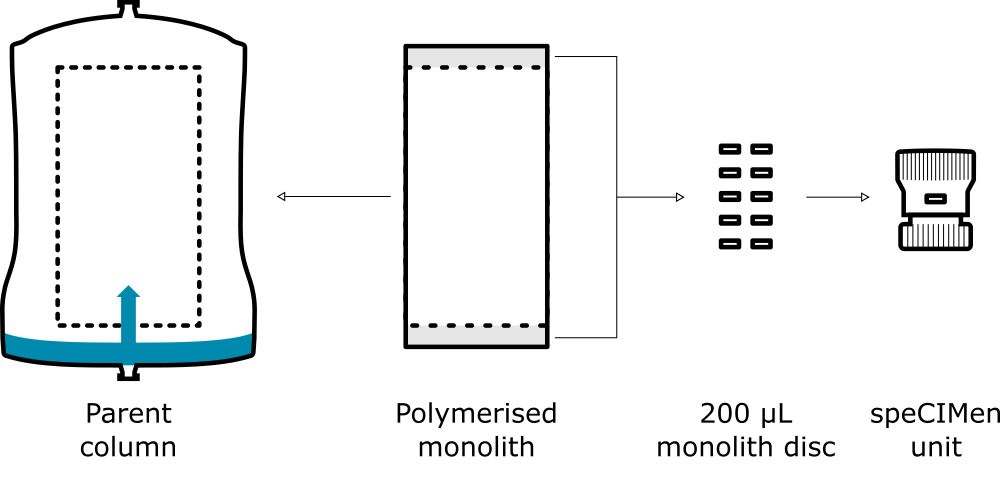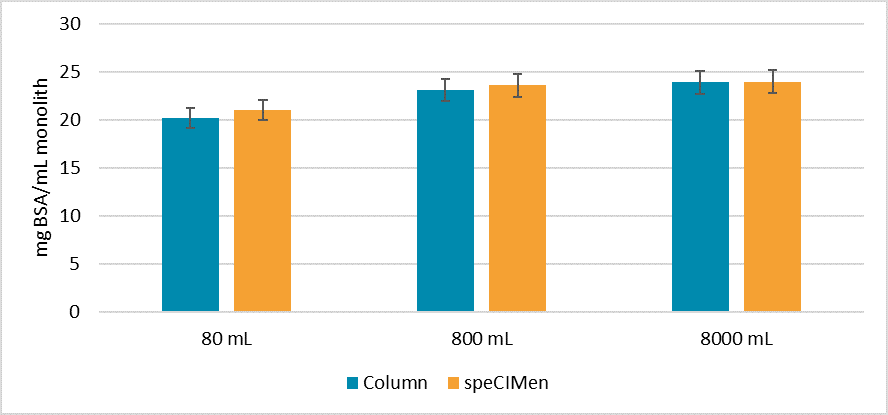Introduction of speCIMen
29Jun2021
Accelerated adoption of advanced therapy medicinal products (ATMP) is leading to the wider use of new therapeutic modalities such as viruses, DNA, RNA. Manufacturers must now contend with an increased molecular diversity, different production systems, impurity profiles, product to contaminant ratios, and other challenges to purification.
Chromatography is frequently employed for purification and concentration of therapeutic products, and it represents a critical step in the production process. Monoliths are a category of chromatography columns typically used for ATMP production. As opposed to chromatography resins, which are packed into a housing from bulk slurry, monoliths are a solid, single-piece structure provided in a ready to use cartridge. Some monolithic columns for large scale purification are produced in single units, and each unit represents its own batch.
Strategies to meet robustness requirements in purification processes are needed to ensure high reproducibility. Testing a resin or column before a purification run is a safe measure to ensure the success of a production campaign. Column efficiency testing is used to evaluate packed bed chromatography columns. Beside packing, batch testing can be used to ensure consistency of supply. Resin can be tested by packing a smaller column with the same batch of material. Monoliths, due to their structure, historically provided limited testing options.
speCIMen - safety valve for your chromatography process
Precise control over manufacturing conditions ensures that a monolith is polymerised homogeneously throughout its structure. With advanced manufacturing and material handling solutions, bulk monolith can be sectioned to extract small units. These small units become testing speCIMen, which provide monoliths with a chromatographic batch testing solution.
SpeCIMen are 200 μL samples extracted from large cGMP compliant monolithic columns (80 mL and larger). Their chromatographic properties are comparable to the bulk monolith placed into the parental column and are representative units of the same batch.
This speCIMen can be used to perform batch testing of a monolithic column before use to ensure even more robust manufacturing processes.

Batch testing
Deviations in process performance arise from various sources, such as upstream sample variability, variability in buffer preparation, variability in the chromatography media, or other. In preparation for a process run, speCIMen can be used to confirm critical process parameters and to improve process control. Evaluation of the sample, buffers and column at smaller scale allows to anticipate the performance of the process and mitigate potential sample loss. Batch testing varies from one process to another, and a suitable approach should be selected.
In applications where chromatographic columns are loaded to maximum capacity, variability in the upstream (e.g. ratio of contaminating protein to target molecule) can affect the loading volume for the chromatographic process step. Precise determination of the binding capacity of the column can be tested for a specific production run, without the need to apply the sample on a large-scale column. The loading volume can be adjusted accurately.
In a different example, where purification relies on step methods with precisely defined buffer parameters, the elution performance can be tested. By testing the buffers and the sample on speCIMen, any variations in buffer conductivity or pH can be anticipated to prevent sample loss. In such way, critical process parameters can be confirmed ahead of purification.

Comparability of Dynamic Binding Capacity
The parental column and its speCIMen have the same dynamic binding capacity for a selected sample (Figure 1). Inherent variability in fermentation processes produces a variable feed stream for the downstream purification. Overloading or underloading the column may lead to sample loss in the flow through, affect the elution performance, or show inaccurate recovery values. With the use of speCIMen, a fraction of a sample can be used ahead of purification to confirm the dynamic binding capacity and determine suitable column loading to prevent sample loss. The data below compares binding capacities measured on speCIMen for the corresponding columns at 80 mL, 800 mL, and 8000 mL during process scale-up.
| Chromatography column | CIMmultus QA 2 μm 80 mL, 800 mL, and 8000 mL speCIMen |
|---|---|
| Method | The chromatography device is equilibrated and loaded with sample (bovine serum albumin, 2 mg/mL) until breakthrough. UV absorbance at 280 nm. Binding buffer: 20 mM Tris-HCl, pH 7.4 |

Product roll-out
SpeCIMen will be available for selected cGMP compliant columns. Each column will be shipped with one unit of speCIMen. Product will be released gradually for all chemistries. Stay tuned for more information.
